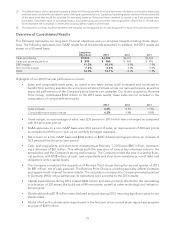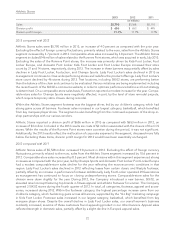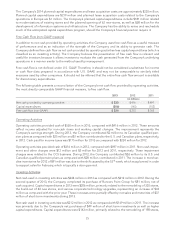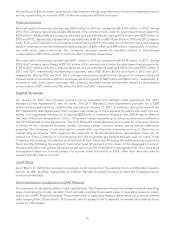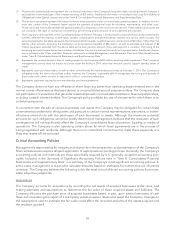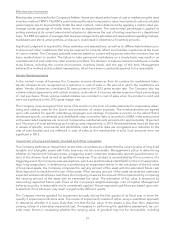Foot Locker 2013 Annual Report Download - page 47
Download and view the complete annual report
Please find page 47 of the 2013 Foot Locker annual report below. You can navigate through the pages in the report by either clicking on the pages listed below, or by using the keyword search tool below to find specific information within the annual report.
insurance and benefit programs, certain foreign exchange transaction gains and losses, and other items. Depre-
ciation and amortization included in corporate expense was $12 million, $13 million, and $11 million in 2013,
2012, and 2011, respectively.
Corporate expense decreased by $32 million to $76 million in 2013, as compared with 2012. Based upon an
internal study of corporate expense, the allocation of such expenses to the operating divisions was increased
thereby reducing corporate expense by $27 million for 2013. In addition, incentive compensation decreased
$11 million and legal expenses decreased by $4 million as 2012 reflected a litigation charge. Additionally, as
noted above depreciation and amortization expense decreased by $1 million. These decreases were partially
offset by $6 million of costs related to the Company’s acquisition and integration of Runners Point Group as well
as an increase of $5 million for share-based compensation expense.
Corporate expense increased by $6 million to $108 million in 2012, as compared with 2011. The increase repre-
sents increased depreciation and amortization of $2 million, $2 million of increased share-based compensation
expense, and a charge of $4 million related to litigation, offset, in part, by expense savings in other corporate
areas. The effect of the 53
rd
week on corporate expense was not significant.
Liquidity and Capital Resources
Liquidity
The Company’s primary source of liquidity has been cash flow from operations, while the principal uses of cash
have been to: fund inventory and other working capital requirements; finance capital expenditures related to
store openings, store remodelings, Internet and mobile sites, information systems, and other support facilities;
make retirement plan contributions, quarterly dividend payments, and interest payments; and fund other cash
requirements to support the development of its short-term and long-term operating strategies. The Company
generally finances real estate with operating leases. Management believes its cash, cash equivalents, and future
cash flow from operations will be adequate to fund these requirements.
As of February 1, 2014, the Company had $426 million of cash and cash equivalents held in foreign jurisdictions.
Because we plan to permanently reinvest our foreign earnings, in accordance with U.S. GAAP, we have not
provided for U.S. federal and state income taxes or foreign withholding taxes that may result from potential
future remittances of undistributed earnings of foreign subsidiaries. Depending on the source, amount, and
timing of a repatriation, some tax may be payable. The Company believes that its cash invested domestically
and future domestic cash flows are sufficient to satisfy domestic requirements.
The Company may also from time to time repurchase its common stock or seek to retire or purchase outstand-
ing debt through open market purchases, privately negotiated transactions, or otherwise. Such repurchases, if
any, will depend on prevailing market conditions, liquidity requirements, contractual restrictions, and other
factors. The amounts involved may be material. On February 20, 2013, the Board of Directors approved a new
3-year, $600 million share repurchase program extending through January 2016, replacing the Company’s pre-
vious $400 million program which terminated on that date. As of February 1, 2014, approximately $371 million
is remaining on this program.
Any material adverse change in customer demand, fashion trends, competitive market forces, or customer accep-
tance of the Company’s merchandise mix and retail locations, uncertainties related to the effect of competitive
products and pricing, the Company’s reliance on a few key vendors for a significant portion of its merchandise
purchases and risks associated with global product sourcing, economic conditions worldwide, the effects of cur-
rency fluctuations, as well as other factors listed under the heading ‘‘Disclosure Regarding Forward-Looking
Statements,’’ could affect the ability of the Company to continue to fund its needs from business operations.
Maintaining access to merchandise that the Company considers appropriate for its business may be subject to
the policies and practices of its key vendors. Therefore, the Company believes that it is critical to continue to
maintain satisfactory relationships with its key vendors. In 2013 and 2012, the Company purchased approxi-
mately 88 percent and 86 percent, respectively, of its merchandise from its top five vendors and expects to
continue to obtain a significant percentage of its athletic product from these vendors in future periods. Approxi-
mately 68 percent in 2013 and 65 percent in 2012 was purchased from one vendor — Nike, Inc.
24






